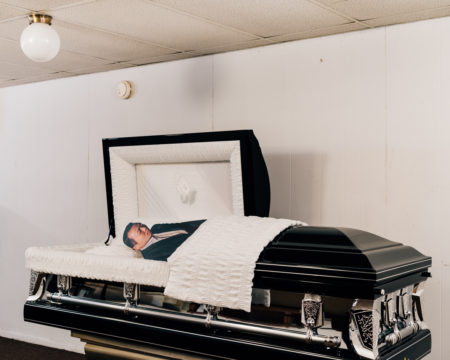‘Insensitive Flesh’
Tommy Kha first caught my attention when I saw a photo of him dressed up as Elvis on the cover of VICE’s 2017 annual photo issue. Actually, it was a photo of a cardboard cutout of a photo of him as Elvis, engulfed in a teal 1950s vintage kitchen scene, with a posture divested of Elvis bravado. His cardboard face revealed no irony, but there was something in his expression that both attracted and mystified me. I am from small-town Indiana. The nostalgic scene was familiar yet off-kilter, like being in between a world I knew and a world I didn’t. I liked the feeling.
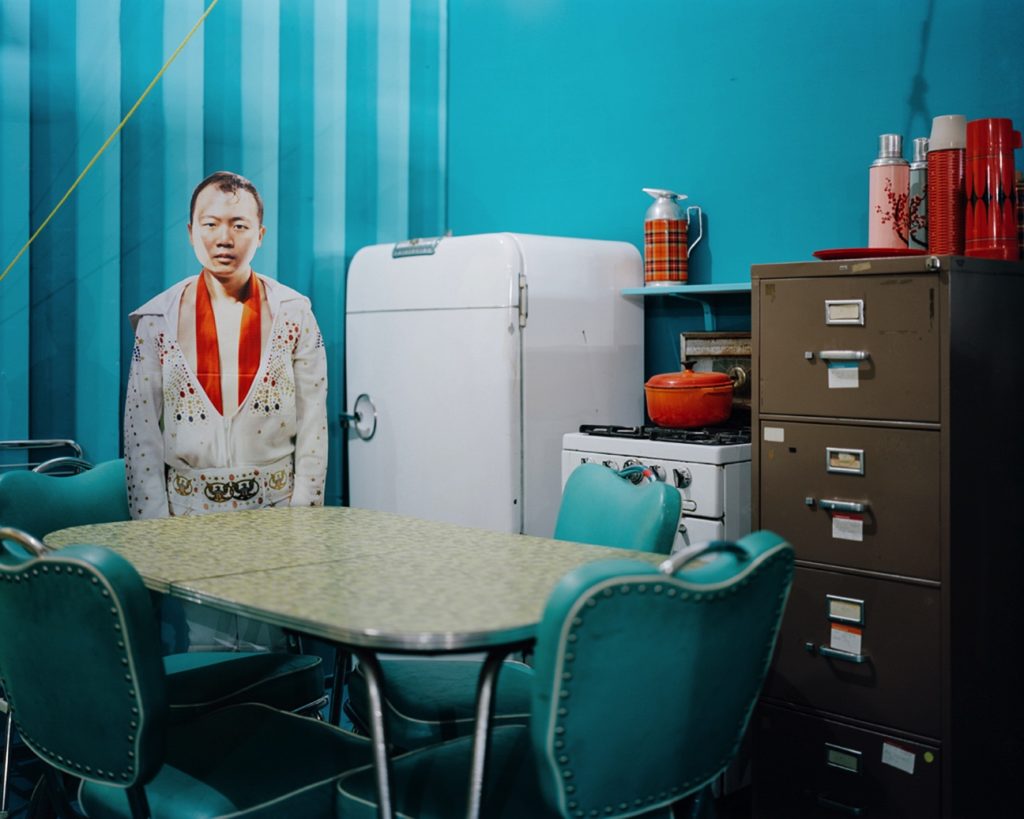
I watched Tommy’s Instagram for more—his self-portraits continued to feed into this feeling as he explored a space of precarity and intimacy. Strangers sandwiched him. Men hoisted him up high over their heads. Friends baptized him in a river. A professional wrestler body-slammed him into a swimming pool. His body is an index for signifiers of conflict and fantasy of conflict, the intimations of ‘fun and games’ alternate with potential violation. It could go either way. I got the sense Tommy enjoyed playing through areas of unease.
I had finished my second season of hosting a documentary television series called GAYCATION when I came across Tommy’s work. I was back home in New York after interviewing hundreds of LGBTQ+ people around the world, often hearing about the discrimination and violence they faced, universally, yet particular to each country, town, and family. I felt my function on that show was to unearth these stories, to create space for people to represent and release their hidden selves. Tommy and I, I felt, were both exploring the space of being ‘other’; queer bodies placed in constant negotiation with the status quo. Tommy’s creative ways of expressing this familiar angst were fresh air to me in a time when I was feeling stuck in a certain seriousness.
Through Instagram we expressed a mutual love for each other’s work. A month later, Tommy came to my apartment in Brooklyn to shoot some photos, with the unspoken understanding that we were, in a way, auditioning each other as artistic comrades.
He shot away on his camera as if learning me through the lens. What started as more neutral ground between us shifted balance into more collaborative, playful exchanges. Tommy introduced me to his latest project—a series of movie poster recreations and he wanted me to be his first test.
I’m not totally sure why I trusted this stranger to pose me as Jane Wyman (as in a 1955 All That Heaven Allows poster), as he, Rock Hudson, would wrap his arms romantically around my head and kiss my cheek—but I did. Maybe I was just that eager for different roleplaying. Maybe I knew the dynamic advertised in that poster and fell into step with it, easily. These images are iconic; they’ve created a standard for how intimacy should look. This makes the experience of producing them awkward—a type of intimacy, as I come to discover.
When you work with Tommy, because these staged self-portraits demand a release, your relationship to him and yourself bends as the photograph morphs into shape. My sense of togetherness, or composure, felt ruffled. The result is laughter, and an uneasy sense of ‘I don’t know what’s going on.’ Somehow I trust him with my uncertainty. It was all kind of uncomfortable, yes. But in our moment, I felt a little freer.
That was my introduction into the world of Tommy Kha.
Here I am, a year later, in his world again.
Tommy recently opened his first solo show “Insensitive Flesh” at Baxter St at the Camera Club of New York, an artist-run non-profit with a gallery in Chinatown. We decide to meet at a cafe in Williamsburg. I want to talk with him more about his work, but in person. I do not come as collaborator, or comrade, or even Jane Wyman. This time I play a role that had been my reality for the duration of GAYCATION. I need to see Tommy interact with his work to understand the story of his art and the pieces in this show.
He arrives carrying a portfolio of his latest pieces, a bit dizzy off a red-eye from a shoot in Palms Springs. After our coffee, he’ll head to Paris to help install a new exhibit of his work. He’s working on pieces for a two-person show this summer. This fall, another solo-show in New York. His work is getting noticed, and he has the jet-lag to prove it.
We go through the photos one by one. I feel intentional and candid as I point out every detail that catches my eye. I feel his confidence shine when he talks about concepts that occupy him: intersubjectivity, authorship, replication, intersectionality.
He does not like the word “identity.” What are we talking about, then? I am in journalist mode. Tommy has clear mastery of the intellectual language that is the foundation of academic institutions and the cultural elite. I like this on a personal level, but annoyingly, I need to understand the emotional core in his work, that I have felt from his work and through his words, but have not yet met with on a gut level.
“What are you feeling when you are making this work?” I ask.
“I want to see myself,” he says.
I think I understand, but I want to know how he uses his camera to do this.
What is he trying to capture?
When will he know that he’s seen himself?
The 13 pieces in “Insensitive Flesh” offer clues. This is a journey of confrontations with self-hood and its shattering as contexts shift. He merges materials, historical eras, parts of people, into miniature moments of a carpet being taken out from underneath you. The feeling is of an intimate dance between detritus and depth.
“I source my own stuff, not from the internet, but through either family albums, my own body, my own representation, and put that out in the world, so a lot it is recycled and cyclical in nature. I’m talking about feeling absent or not represented in a Western Media context,” he says.
Tommy shows me the photos of 3D-printed masks made from his photographed face– ‘photo-sculptural’ self-portraits. In earlier work, he taped the masks over the faces of traditional European busts, which he then photographed and presented, in line with the genre conventions of a photo of found objects or a historical relic.
That earlier series also includes photographs where emblematic–looking people hold his ‘face-masks’ over theirs. The masks look sutured on; making us look harder at the divisions or boundaries between where one thing ends and one thing starts. You almost always do a double take.
In its latest iteration, Headtown (II), the resin mask sits alone, a strangely still face, ensconced like an overgrown bon-bon in a just-opened gift box. This one has gotten away from its context of issue, the conditions of its receipt. To me, its meaning disperses into drifting connotations when the mask resides in its own space.
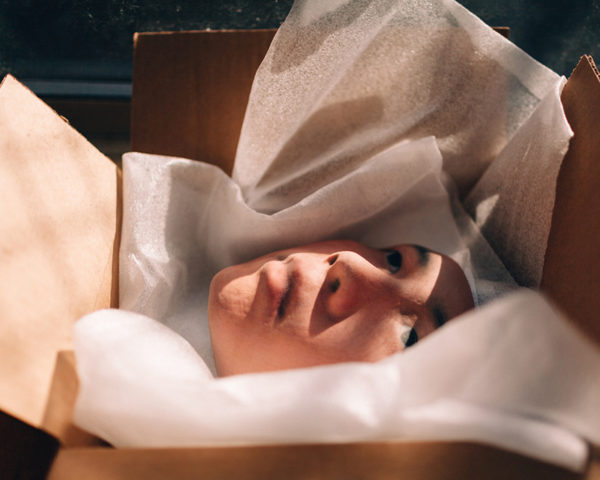
Tommy’s work is rife with references to how contexts and conventions shape our expectations, but he isn’t interested in correcting people or making a cultural shift. Those dynamics are in play already, he says. Instead, he wants to consciously and subconsciously insert these experiences that other people can look at and say: Oh yeah, he’s just out of place there. Maybe that is the point.
This takes on new depth when he tells me about his upbringing.
As a kid growing up in Memphis, Tommy says he never felt like he belonged in any space in particular. He went to an all-black elementary school. “I thought all teachers were white,” he says. Outside of his family, he saw no one who resembled him, whether in real life or television or the movies.
“I want to explore my otherness, the extent of my otherness. I’m Asian, I’m queer, I’m from the American south, I have an accent, I’m left-handed. Things like that.”
Growing up, he was drawn to “Wonder Woman…Buffy The Vampire Slayer…shape-shifting archetypes.” In a blink of an eye, women switch from ordinary to beyond-human, motored by a magic that allows them to parlay freakishness into heroism.
I can relate. Transformers. Care Bears. James Dean. Queerness in relationship to our childhood environment, I tell him. Being outside the status quo is uncomfortable. To varying degrees, from small-town Indiana to Memphis, TN your identity and how you play it must be motile, a button-press away from a safer iteration.
People who don’t fit in learn to see through the eyes of others. We need to in order to adapt. I felt I had to reconfigure and suppress my more feminine aspects. The threat of violence was not always stark, but was confusing because of how deeply it was embedded in everyday life. I saw how real the threat was to many participants on GAYCATION. I had spoken to mothers who had sons and daughters that were murdered simply for walking down the street.
I share with Tommy that I realize I would have been treated differently as a white kid in Tennessee; I don’t share his particular intersection and maybe that disqualifies me from experiencing comparable marginalizations. As we talk, I realize these differences as well as our growing commonalities. Cultural chameleon, performance artist, public figure. Self, always on the move.
These thoughts echo as I recall the quote by Claude Cahun that inspired the title of his show, “Insensitive Flesh.” “If I vibrate with vibrations other than yours, must you conclude that my flesh is insensitive?” (Héroïnes, 1925).
Tommy cites Cahun, who is best known for androgynous self-portraits and gender role reversals, as one of his influences. In this show, what is being reversed is not explicit.
“My performed self in my photographs are constantly changing in every photograph, too, and then so is the source material, ” Tommy says. He mentions Hegel; I wonder how Tommy’s dialectic affects his real life. The cardboard Tommy seems like a springboard for this question.
In “Insensitive Flesh,” cardboard Tommy is fully-clothed and cut off at the torso. Previously he has worn only an orange Speedo. He’s worn Elvis too. Tommy explains of his cardboard stand-in, “it’s a blueprint for how people can interact with me.”
In the photograph Constellation (XII), Whitehaven Memphis, cardboard Tommy is propped up next to his mother in his childhood bedroom, on his childhood bed. The bedroom is immaculate yet soft with its pale hues, a round bamboo fan laid upon the bed. I ask a lot of Whys, why the bedroom, why do they sit like that, why the fan on the bed? Everything looks like an arranged still life yet made more beautiful by it’s interruption by the fraught, almost devastating tension between cardboard cut-in-half Tommy and this mother.
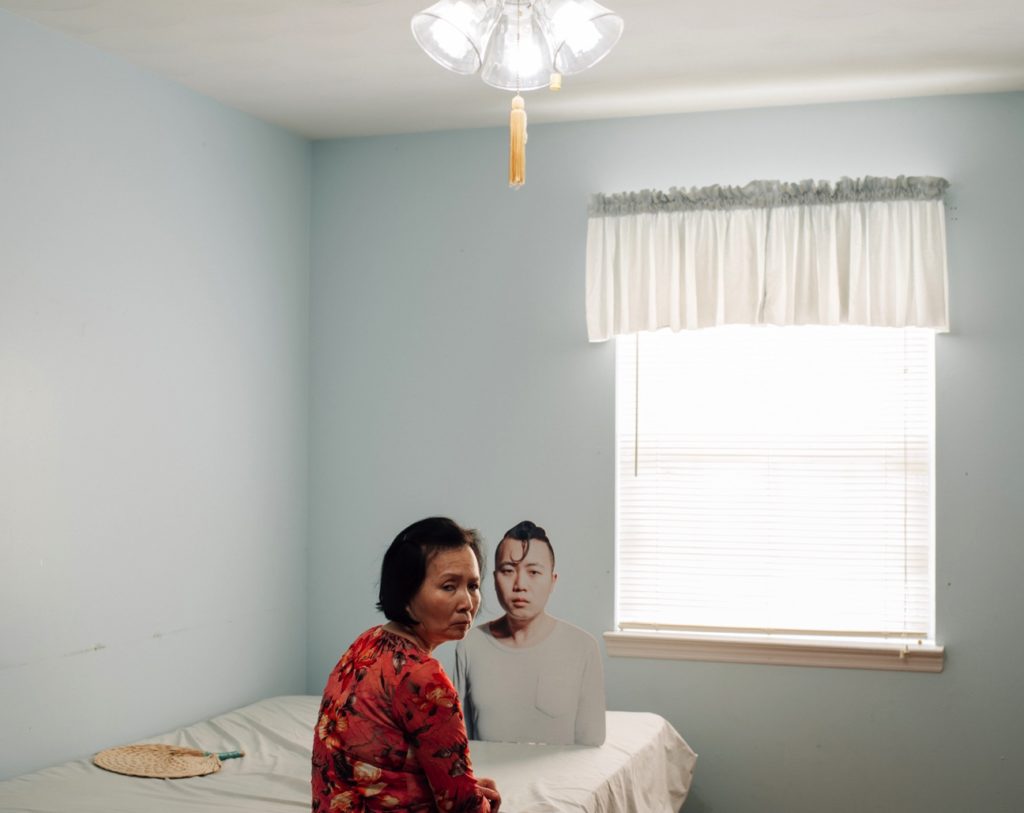
“That cardboard cutout is the most neutral expression I made and, in a way, she only sees me like that, ” he says with a quick shrug.
Tommy’s mother has been a big part of his work. In earlier photographs, he poses next to her in what feels like would be very personal exchanges, except they appear always at a distance, looking off. She mostly is looking away.
“How does your mom feel about being part of your work?”
“She doesn’t understand it, really…she has no relationship to art.”
“Where is your family from?”
“1930s China and Vietnam. She’s Chinese-Vietnamese”
“What about your dad?”
“Who cares?”
“Oh. Your dad was never around?”
“No, never around.” He fidgets with the curl on his forehead.
“Same here.”
“He had like four children with two other women. He crashed a car high on cocaine,” he adds, “There’s a gritty detail for you.”
That gets my eyebrows to raise.
Tommy was raised by his mother…and grandmother too.
“Very matriarchal,” he says with a beam.
“Same here,” I say.
He calls his photographs with his mother, “performative investigations”—a way to have safe conversations in order better understand himself. Tommy recently went back home to photograph his mother in his childhood home—one of the last opportunities to spend time in the house that she is about to sell. This is an opportunity, he feels, to see themselves from within the house, eyes peering out from the wallpaper.
In Constellation (XII), Tommy’s mother sits close to his cutout self, which suggests a potential for warmth between them. But her face is turned away from her cardboard son, eyes askance at the camera with what looks like reluctant and dreadful suspicion—or perhaps she was caught by surprise. Her posture is slumped; she doesn’t need to pretend everything is ‘great’. She survived the Fall of Saigon—she has no time for games. But she plays along with his performance investigations anyway. It feels like they are at a crossroads that no one is ready to name.
“Tell me more about your mom,” I continue.
“She doesn’t know I’m gay. But I’m sure she suspects it,” he adds, matter-of-factly, as if giving in to this.
I’m a bit shocked. I had assumed this entire time that she knew. Realizing now, I’d misinterpreted the cardboard, their photos together, the tension, even, as evidence of a deeper closeness. His work was also obviously queer to me. Was his mother unaware of gay iconography?
“Has your mom not seen your work?” I add.
“My mom doesn’t have access to the internet…eventually she will find out.”
I joke with Tommy that I feel like I’ve turned our conversation into a GAYCATION episode, but more seriously, “I wish I had known you when we were filming the Deep South one.”
“I watched the episode where you went to Japan,” he says, excited at the mention of GAYCATION. He trails off a little. I can tell by his reaction that he’s watched the whole episode. I had learned I could tell from people’s faces whether they had or not. It had been an intense episode.
We talk about the scene where a young Japanese man sits down with his mother to tell her that he likes men. She goes through a range of micro-expressions and chokes back tears. She says, with a small voice, “I can’t do this,” and quickly leaves the apartment. I sit there with the son for a long time; no words. The mother does eventually come back at the urging of a friend. She looks humble and brave, but her sadness is clear. She faces her son and tells him that she loves him and they will work this out together.
“Uh, that made me cry,” Tommy says.
I can’t imagine Tommy crying.
But I also am aware that my imagination of Tommy is inseparable from cardboard Tommy and camera operator Tommy.
“Ugh, coming out sucks, as you know!” he says in exasperation about the conversation he’s been stalling to have.
His new work, Assembly (II) looks like a new space to work out the potentialities presented by their component pieces: mother and son with their fragments fused. The resulting piece is an image that is murky, almost deformed, as the edges of the puzzle pieces don’t match up quite right, the skin tones shift, the harshness in someone’s turn of expression belongs to one of them or both. The image as a whole is a space in-between the past and present.
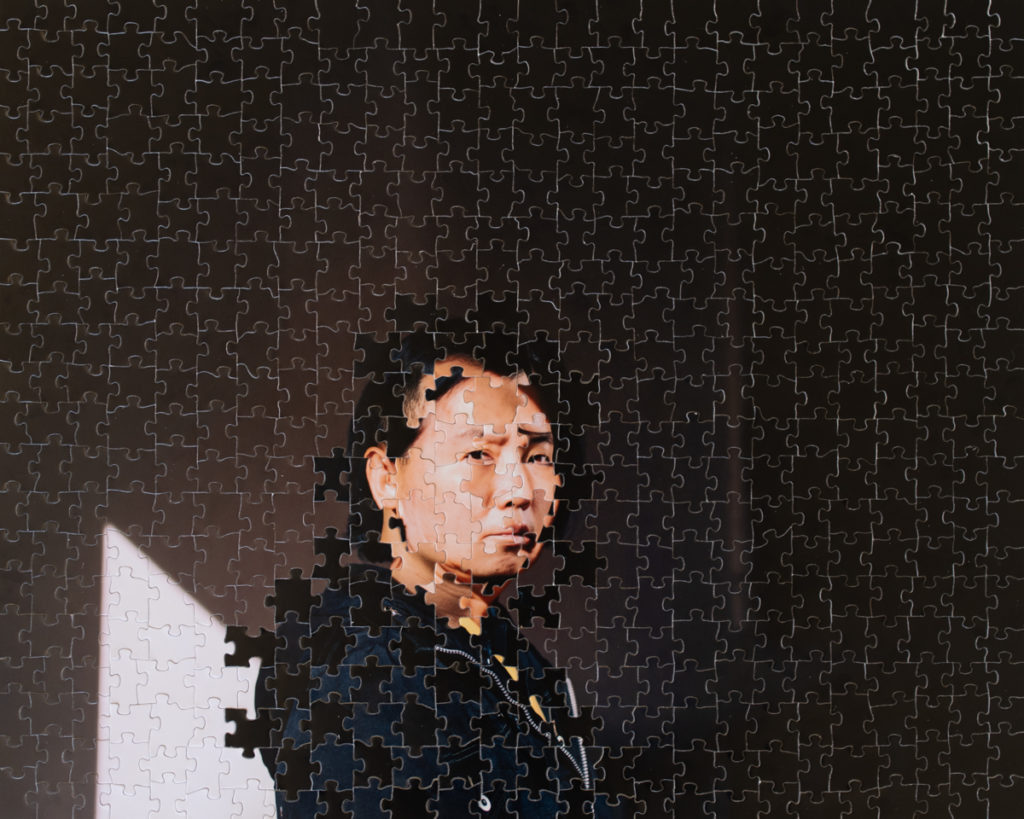
“Half her DNA is my DNA,” he says as he points at the puzzle pieces in the photo. In these “half self-portraits” he’s experimenting with the pieces of what they already have “where do I end and where does she begin?”
When he works with her pieces he must contemplate her within the field of presence her person occupies most tangibly: her physical body. Tommy can begin to access beyond the outlines of mother, survivor, the woman he cannot talk to.
“After the war in Vietnam,” Tommy explains, “She cleaned the minefields in one of the indoctrination camps. Somehow she didn’t blow herself up.” He conjectures that his art might be “antagonistic, because she hid so much…the more I understand her history, the less I know about her somehow.” The further he moves from his perspectival understanding of her, the more he sees.
Maybe the responsibility of articulating what he sees requires a stage of fragmentation.
“No one in my family talked to me when I studied art in undergrad,” he tells me, “not until I got into Yale and then they took it more seriously. My family is all about appearances and I don’t like being told what to do.”
Tommy’s appearance as a cardboard son was an insight he manifested in the form of art. This is a confrontation that also marks a point of hope. Vulnerability and resistance made static–through masks, plastic, replicated images–pay a form of respect to the Asian cultural value of “saving face“, while offering a challenge. The challenge is not a revolt or wholesale conformity to a new status quo. These pieces speak to the potential of incompleteness and separation in this completed art-image.
I see their relationship with more empathetic eyes now. The silence shared in their photos, as in life, feels more like an unspoken promise to acknowledge unfinished business.
One thing I’ve learned first hand, and on GAYCATION, is that traumatized people prioritize survival through escaping the present. The shock of trauma is a text to unravel. If the text is always in movement, a “constant slippage,” the threat of violence is a chilling effect on communication. Tommy and his mom don’t yet talk about personal things. Their relationship right now is a dance around emotional minefields. Tommy knows coming out as gay could blow up the whole thing; that his mother will have to pay the social consequences that go along with acknowledging her choice in rejecting him or accepting him.
So the story is incomplete, I imagine Tommy saying, but we are entangled. It is okay that we are broken in places and parts of us are missing from the other.
What happens if I speak? What will happen to the art? What will we be when the blueprint is gone?
It could go either way.
“If she’s not ok with me coming out, then these are the pictures that survived at a time when we were ok with each other,” he tells me.
“That makes me sad,” I say, “But I understand. It’s okay.”
We sit in silence for a minute.
This happened a lot during my conversations on GAYCATION. I found myself sitting there, in quiet, sometimes speaking up to say “everything will be okay,” even though there was no real guarantee. I could not control the outcome but I could provide witness. I saw them, and that seemed to count for something.
-Ian Daniel
